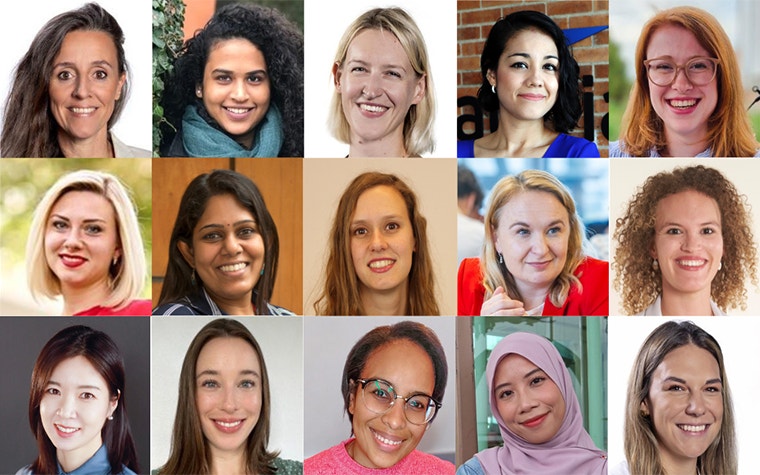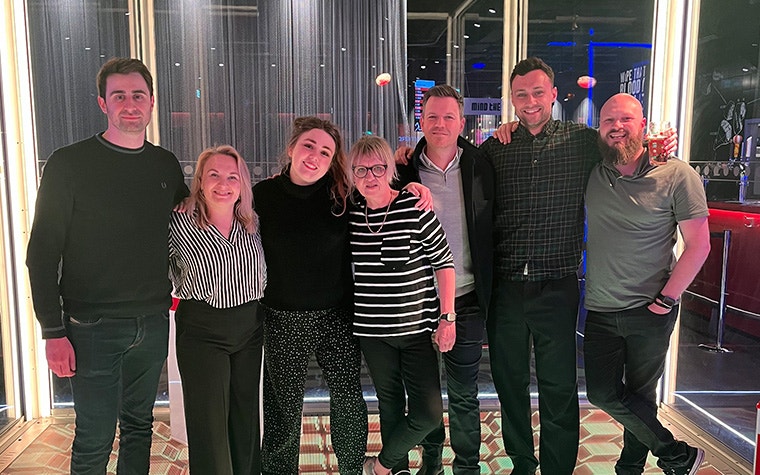LIFE AT MATERIALISE
Who Runs Our (AM) World? Girls! Celebrating Our Talented, Ambitious Women Shaping the Industry

Beyoncé is a music icon. But did you know she’s also a vocal advocate for race and gender equality? You only have to listen to the lyrics of her anthem, “Run the World (Girls),” to understand that she wants to empower more females in society. She even said: “I’m going to continue to write songs that give women strength.”1 While it didn’t receive critical acclaim like some of her other hits, it did take on a much bigger cultural significance. The song celebrated women and inspired them to aspire to greater things, especially career-wise. At Materialise, we also share this philosophy.
Every year, more women join our workforce and enter people management positions worldwide. In 2023, both areas increased by 2% from the previous year, rising from 36% to 38%.2 This growth is because we encourage candidates from all walks of life to join us, regardless of gender, race, sexuality, or anything else. We hire based on a person’s qualifications, motivation, and experience — and we believe these increases are due to women feeling empowered to apply for different roles within our company. This is an exciting trend for us as diversity in the workplace increases creativity, innovation, and commercial success. In this article, we spoke to three inspirational women at Materialise — Joanne Staples, Tem Bertels, and Nora Toure — about their additive manufacturing (AM) journey, as they shared their challenges, triumphs, and tips about how to get more women into the industry.
Women are shockingly underrepresented in AM. In a recent survey examining gender distribution in 3D printing, 14.7% of professional respondents were females.3 This illustrates the gender disparity in the industry. “I’ve been in the AM industry since 2009, and there were not that many women in the past,” says Nora Toure, Director of Sales, Medical Device Companies for Materialise Medical. “When I joined my first company in AM, I didn’t feel entirely welcome in the industry back then. When I moved to the US from Europe for a new job opportunity in my early 20s, rebuilding my local network and feeling accepted was more difficult than anticipated. I couldn’t find an existing community to welcome me, so I founded the organization Women in 3D Printing,” she says.
“I agree,” says Joanne Staples, UK Sales Manager at Materialise Medical. “In the past, my biggest challenge was trying to fit the mold — AM was a male-dominated ‘old boys’ network,’ and I wanted to fit in. But now I have more experience; I’m more comfortable in my own skin. I’ve had brilliant managers who have shaped my career path along the way and strong female characters within Materialise and the industry who support me, which has helped,” she says.


“I wanted to find more female voices and role models,” continues Nora. “I started interviewing women once a month, and it just grew organically. As a result, Women in 3D Printing was born. Now, we have over 30,000 members in more than 38 countries, and we’re still growing. But AM is still a niche industry. To increase female representation and ensure we continue to innovate, we need to uncover new, diverse talent. And this is more than an industry problem; we must look at the root cause, which I believe is found in our education system in society.”
Breaking barriers: encourage more women into STEM subjects
Far fewer women also take up science, technology, engineering, and mathematics (STEM) subjects. This could be because of several factors, such as encouraging pupils to stick to jobs linked to traditional gender roles, the historic underrepresentation of women in specific fields, and a bias toward male-orientated product development and solutions.
“I think the school system plays a pivotal role,” says Tem Bertels, Product Manager at Materialise Software. “There are summer STEM camps, but there’s also the assumption in society that girls can’t do STEM subjects. This perpetuates in our professional lives, too. We need to encourage females at an early age and tell them at home, school, and in the workplace that they can do technical things,” she says. Females are less likely to have jobs in STEM employment, with 15% compared to 84% of men, hindering employment talent pools for every industry, not just AM.4


“Yes, it starts from school,” says Joanne. “For example, my youngest gets excited when she boards a plane because she wants to be an air hostess. But I like challenging her, so I ask: “Why don’t you want to fly the plane yourself?” And she replies: “It’s a man's job.” That gets my blood boiling; it’s absolutely not a man’s job! We project this onto young children, jobs for boys and girls, but we need to challenge that as a society and shake it up,” says Joanne passionately. Joanne’s daughter’s perception isn’t unusual. Studies show that children as young as five believe that girls aren’t as good at mathematics as boys, which influences female uptake into STEM-related professions.5
If women don’t enter STEM roles, we’re losing valuable insights that could help improve product development and new applications — as well as not catering to half of the global population. A variety of products we use in society, from smartphones and GPS navigation systems to crash test dummies, didn’t involve women in the development process. As a result, some smartphone sizes are not a good fit for female hands, and the original navigation system didn’t recognize female voices. 6 And even now, women are less likely to survive car accidents because the average test dummy is still designed to represent the average man, not woman.7
So, revamping the education system and challenging typical gender norms are two pressing issues that must be addressed. However, companies can also play a role in increasing their female workforce, particularly in AM and other STEM-based organizations and institutions. How? By providing effective leadership and management, fostering an inclusive company culture, and welcoming diverse ideas and opinions.
How a diverse workforce breeds creativity and provides better results
Research studies show that diverse teams are critical to a company’s success. Nonhomogeneous teams tend to be smarter and may challenge people’s brains to think differently and sharpen performance levels.8 “Women are just as capable as men,” says Nora. “Having more diverse teams, be that women, people of color, or neurodivergent people, will bring so much to your organization. I don’t think anyone should change “to fit the mold”; more people need to speak their minds and hold their heads high. Materialise leads the way in that respect: we have women in high places across the company. Just look at our CEO [Brigitte de Vet]: she's a strong, articulate woman running the company.”
A company’s management and strategy affect all parts of the business, from employee satisfaction to profitability and work-life balance. Closing the gender divide and adopting more women at Materialise has helped employees with workplace flexibility and career progression. “Materialise is a very understanding company. Managers will accommodate your personal situation and adapt to help fit your needs,” explains Tem.
“I’ve had brilliant managers throughout my career at Materialise. Emma [Webster] convinced me to rejoin medical sales after a short stint in retail. I was very nervous being a single parent in an industry that usually struggles to support this type of family unit. However, Materialise enabled me to make it work, and I have the balance at home and passion for work that I’ve always craved,” says Joanne. “I truly believe this is a great company for women to join. It’s incredibly powerful to have a female CEO who’s so passionate and engrossed in our business. She’s a real inspiration.”


A report published by McKinsey even states that more ethnic and culturally diverse teams outperform homogeneous ones regarding profitability by around 36%, and companies with more than 30% of women executives were more likely to outperform rivals by between 10 – 30%.9 You only have to look at our current CEO's progression to see the impact women in senior positions can have on a company. Before becoming CEO, Brigitte led Materialise Medical and quickly transformed it into our most profitable business unit for many years. And just recently, she won TCT’s Women in 3D Printing Innovator Award! So, there’s no reason why more women can’t undertake challenging roles and the top jobs in AM and elsewhere.
Looking ahead: how our women are transforming industries and their tips for their peers in AM
Many industries can benefit from AM, as 3D printing and our end-to-end solutions can enable novel experiences, facilitate innovative product development, and help create transformative 3D printing applications. This ranges from manufacturing and medtech to consumer goods and everything in between. And our women are at the forefront of this transformation.
“I'm trying really hard to get on to the national agenda in the UK and enable the use of our 3D technology in the NHS,” states Joanne. “The NHS is the main hospital body in the UK and is a government-based health provision that covers you from cradle to grave. We’re using 3D software and solutions in 60 hospitals, and they have individual point-of-care 3D printing centers. However, there are 250 hospitals in the UK, so we have a long way to go. Access for all who need it is one of my main personal drivers in a society littered with health inequalities.
“My parents live rurally and don’t have access to these top innovative technologies due to the devolved funding systems. I have experienced family members who would have had different clinical outcomes had 3D technology been available to them. Trying to change this for the better is what motivates me, so my children will not have to fight for the best possible clinical outcomes,” concludes Joanne.


AM isn’t just revolutionizing healthcare. More companies are also seeing the benefit of on-demand, digital manufacturing to mitigate supply chain disruption and reduce surplus stock, areas in which AM excels. “I’ve always wanted to make a real difference to customers and help them improve their processes. I’ve had this feeling early on in my career from finance and telecommunication to 3D printing,” explains Tem. “I like being the person in between people and technology, and I enjoy working on projects that help our customers get more out of their processes. It brings me great happiness; that’s why working on the next version of the Materialise CO-AM Software Platform is a current career highlight. It will allow manufacturers to access all our solutions and products under one platform, and it can be fully integrated into their existing setup. They won’t need separate AM and conventional manufacturing systems to run their operations; they can use one seamless solution throughout their entire production facility.”
AM can change the lives of millions, and that’s what Nora wants to achieve as she switched from Materialise Software to the Medical division and her work with Women in 3D Printing. “I transitioned from Software to Medical because I see personalization in healthcare touching countless lives around the globe. This evolution was scary at first but totally worth it. I’ve gained many skills throughout my career, but becoming a mother inspired me and has helped me improve my leadership skills, which I can take into my personal and professional life. Obviously, taking Women in 3D Printing to the next level is another goal that I want to achieve, along with moving the industry forward. That’s why we need more diversity in AM and everywhere. We need to encourage more internships that appeal to women and hire more female interns. We need to arrange schemes like ‘bring your daughter to work’ day or hire organizations supporting gender equality and workplace equity, and companies to embrace them.
“Finally, we should get more people interested in 3D printing, whatever their background. I don’t have a technical background, but I’ve carved out a career in AM, and so can other women. It’s a cool industry, and its popularity will continue to snowball. We need to encourage more people to join and let them be themselves so AM can grow. That will benefit not only 3D printing but other industries too,” says Nora.
“We need more women in the industry. And I’m like Nora: I don’t have a technical background. In fact, when I joined Materialise, I was somebody who couldn't even program my Sky+ cable box! But being curious, open-minded, and adventurous helped me learn and upskill. Materialise has that sort of environment. However, I feel women offer something else to a team’s dynamic. We are naturally compassionate and empathic and are more aware of wider socioeconomic problems. I find we generally look at things more holistically. This allows us to challenge the status quo and look for better outcomes for our colleagues, patients, and whoever we work with.”
- Wikipedia: Run the World (Girls) – (quote taken from the cover art of Beyoncé's album 'I was Here')
- Materialise Sustainability Report 2023
- Alexander Daniels Global: Salary Survey Report 2024
- 3D Printing Academy for Girls: Why Our Work Matters
- Mary Ann Sieghart: The Authority Gap, Penguin Random House UK, 2021, pp.14
- 3Dnatives: What is the Status of Women in the 3D Printing Industry?
- Discover Magazine: Why Are There No Crash Test Dummies That Represent Average Women?
- Harvard Business Review: Why Diverse Teams Are Smarter
- McKinsey & Company: Diversity Wins — How Inclusion Matters
Share on:

Biography
Joanne Staples

Biography
Tem Bertels

Biography
Nora Toure
You might also like
Never miss a story like this. Get curated content delivered straight to your inbox.
